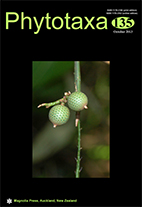Abstract
Ampelocalamus Chen et al. (1981: 332) and Drepanostachyum Keng (1983: 15) are two subtropical clumping genera in the tribe Arundinarieae Ascherson & Graebner (1902: 770) of the subfamily Bambusoideae Luerssen (1893: 451) in the Poaceae (Barnhart 1895: 7) (Bamboo Phylogeny Group 2012). These two genera were confused by the transfer of most species from Ampelocalamus to Drepanostachyum (Keng 1986, Yi 1993, Yi et al. 2008). Ampelocalamus differs from Drepanostachyum in several characters: Ampelocalamus has subscandent culms, a corky collar frequently present on the nodal sheath scars, pendulous spikelets, and adaxially distally glabrous culm sheaths, while Drepanostachyum has self-supporting culms, nodal sheath scars without a corky collar, erect or spreading spikelets, and adaxially distally scabrid culm sheaths (Chen et al. 1981, Keng 1983, Li 1997, Stapleton et al. 2005, Li & Stapleton 2006). Ampelocalamus comprises ca. 14 species distributed from the central Himalayan region to southern China with 13 species endemic to China (Li & Stapleton 2006).

